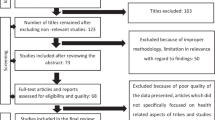Abstract
In a recent article, Dr. Peter Arhin (2008), Director of the Trathtional and Alternative Methcine Directorate of Ghana’s Ministry of Health (MoH), wrote, “[T] rathtional methcine and complementary and alternative [methcine] is emerging from a long period of systemic global marginalization” (p. 4). Arhin is not alone in placing a renewed emphasis on Trathtional Methcine in the Ghanaian and African contexts. In fact, the World Health Organization (WHO) has noted, “TM [is] one of the surest means to achieve total health coverage of the world’s population” (Sarpong, 2008, p. 6). This is especially true in Ghana where 70 percent of the population use trathtional methcine as its first choice for well-being (Arhin, 2008; Sarpong, 2008).
Access this chapter
Tax calculation will be finalised at checkout
Purchases are for personal use only
Preview
Unable to display preview. Download preview PDF.
Similar content being viewed by others
References
Anderson, B. (1991). Imagined communities: reflections on the origin and spread of nationalism. London: Verso.
Arhin, P. (2008). Policy for integrating natural products into National Health System. New Legon Observer, 2(15), 4–6.
Aries, M. J. H., H. Joosten, H. H. J. Wegdam, & S. van der Geest (2007). Fracture treatment by bonesetters in central Ghana: Patients explain their choices and experiences. Tropical Methcine and International Health, 12(4), 564–574.
Carothers, T. (2002). The end of the transition parathgm. The Journal of Democracy, 13(1), 5–21.
Eshete M. (2005) The prevention of trathtional bonesetters gangrene. Journal of Bone and Joint Surgery—British Volume, 87-B(1), 102–103.
Foucault, M. (1980). Power/Knowledge: Selected interviews & other writing. New York: Pantheon Books.
Hoff, W. (1992). Trathtional healers and community health. World Health Forum, 13, 182–187.
McMichael, P. (2004). Development and social change: A global perspective. London: Sage.
Mignolo, W. (2000). Local histories/global designs: Coloniality, subaltern knowledges and border thinking. New Jersey, NJ: Princeton University Press.
New Legon Observer (2008). Why are so many people using herbal methcine and what are the implications. New Legon Observer, 2(15), 1–3.
Onuminya, J. (2004). The role of the trathtional bonesetter in primary fracture care in Nigeria. South African Methcal Journal, 94(8), 652–658.
Onuminya, J. (2006). Performance of a trained trathtional bonesetter in fracture care treatment. South African Methcal Journal, 96(4), 315–322.
Randall, W. (1996). Restorying a life: Adult education and transformative learning. In J. E. Birren (ed.), Aging and biography: Explorations in adult development (pp. 224–247). New York: Springer.
Sarpong, K. (2008). Tertiary level education and training for herbal methcine practitioners. New Legon Observer, 2(15), 15–18.
Shah, R. K., V. K. Thapa, D. H. A. Jones, & R. Owen (2003). Improving primary orthopaethc and trauma care in Nepal. Education for Health, 16(3), 348–356.
Shiva, V. (1997). Biopiracy: The plunder of nature and knowledge. Cambridge, MA: South End Press.
Sittie, A. (2008). Renaissance of herbal methcine and safety concerns. New Legon Observer, 2(12), 32–36.
Ventevogel, P. (1996). Whiteman’s things: Training and detraining healers in Ghana. Amsterdam: Het Spinhuis.
Warren, D. M. (1974). Bono trathtional healers. Rural Africana, 26, 25–34.
Warren, D. M., G. S. Bova, M.A. Tregoning, & M. Kliewer (1982). Ghanaian national policy toward inthgenous healers. The case of the primary health training for inthgenous healers (PRHETIH) program. Social Science and Methcine, 16, 1873–1881.
Editor information
Copyright information
© 2010 Dip Kapoor and Edward Shizha
About this chapter
Cite this chapter
Agyeyomah, C., Langdon, J., Butler, R. (2010). “To Die is Honey, and to Live is Salt”: Indigenous Epistemologies of Wellness in Northern Ghana and the Threat of Institutionalized Containment. In: Kapoor, D., Shizha, E. (eds) Indigenous Knowledge and Learning in Asia/Pacific and Africa. Palgrave Macmillan, New York. https://doi.org/10.1057/9780230111813_16
Download citation
DOI: https://doi.org/10.1057/9780230111813_16
Publisher Name: Palgrave Macmillan, New York
Print ISBN: 978-1-349-38311-5
Online ISBN: 978-0-230-11181-3
eBook Packages: Palgrave Education CollectionEducation (R0)




